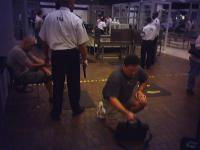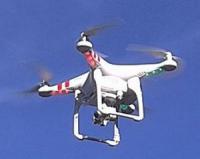-
TSA deploys AtHoc crisis communication solution in 200 airports
TSA joins the Customs and Border Protection (CBP) and Immigration and Customs Enforcement (ICE) in deploying AtHoc to improve crisis communication in 200 U.S. airports. TSA’s Alert Warning System (AWS), based on AtHoc, will enable real-time accountability of TSA staff during routine, emergency, and critical events.
-
-
Thwarted train attack in France highlights U.S. rail vulnerability
Airports are protected by several layers of security, but railroad stations have minimal, if any, protective measures, and there are no security checks through which those who take the train must pass. The attempted attack on the high-speed train from Brussels to Paris, an attack foiled by the quick courageous action of three Americans and Briton, only highlights the vulnerability to attack of U.S. rail. Security experts say, however, that trains remain vulnerable to terrorist attacks. A recent study, which analyzed terrorist attacks over a 30-year period from 1982 to 2011, found that terrorists have shifted their focus in recent years away from attacking airlines to attacking subway and rail systems. The deadliest attacks in the decade 2002-2011 were against subway and commuter rail systems.
-
-
Airport body scanners fail to provide promised security
Since 2008, the Transportation Security Administration (TSA) has spent $160 million on scanners to identify passengers which may be carrying weapons. These scanners, however, do not perform as well as was originally believed.Independent audits have found that the system provides weak protection against determined adversaries.A display of the mock weapons and explosives whichthat investigators were able to get through the scanners included various size folding knives, a kitchen knife, explosive-less hand grenades, a handled awl, a lighter, handguns, ammunition, a shotgun shell, various bludgeons, and a nunchaku.
-
-
U.S., Canada, Mexico create North American Trusted Traveler network

DHS said it has joined Public Safety Canada and the Secretariat of Governance of Mexico in outlining the first steps toward the creation of a North American Trusted Traveler network. The new agreement, signed on 10 July 2015, will make it easier for eligible travelers in the United States, Mexico, and Canada to apply for expedited screening programs. Eligible travelers will be able to apply for each program beginning in 2016.
-
-
D.C. security gaps exposed by gyrocopter landing on Capitol grounds: Senate panel
A Senate committee has concluded that the Florida man who flew a one-man gyrocopter and landed it on the U.S. Capitol grounds, had exposed security gaps and inadequate coordination among the agencies charged with protecting the Capitol, the White House, and other Washington landmarks. In addition to calling for better coordination among the different agencies responsible for securing important sites in Washington, D.C., the committee strongly recommends seeking new “technological solutions” to spot similar flights in the future, suggesting that Congress should also consider increasing penalties for those who breach the restricted airspace.
-
-
New air traffic management system to make drone air traffic safer

Researchers are now working on a new, low-altitude traffic management system to keep fast-moving flyers safer as they cruise through increasingly crowded skies. A handful of organizations are participating in the first phase of the NASA Ames Unmanned Aerial Systems Traffic Management project to enable safer use of low-altitude airspace, of 500 feet and below, where autonomous aerial vehicles, helicopters, gliders, and other general aircraft are operating.
-
-
Israeli port evacuated after container emitting suspicious radioactive radiation detected
Israeli authorities on Monday evacuated the Ashdod port in southern Israel after an Israeli shipping container which arrived on a Chinese ship was detected to emit irregular radioactive radiation. By mid-afternoon, the port went back to normal operation. Israeli ports have installed advanced radioactive radiation systems in an effort to detect “dirty bombs” which terrorists may try to smuggle into Israel.
-
-
Bomb-proof lining contains explosion in aircraft’s luggage hold
A bomb-proof lining developed by an international team of scientists has successfully contained blasts in a series of controlled explosions in the luggage hold of a Boeing 747 and an Airbus 321. The Fly-Bag, which lines an aircraft’s luggage hold with multiple layers of novel fabrics and composites, was tested last week under increasing explosive charges on disused planes. The tests, using this technology, have demonstrated that a plane’s luggage hold may be able to contain the force of an explosion should a device concealed within a passenger’s luggage be detonated during a flight.
-
-
Los Alamos National Laboratory’s annual Hazmat Challenge begins today
Twelve hazardous materials response teams from New Mexico, Missouri, and Nebraska test their skills in a series of graded, timed exercises at the 19th annual Hazmat Challenge held 27-31 July at Los Alamos National Laboratory. The competition tests skills of hazardous materials response teams in responding to simulated hazardous materials emergencies involving an aircraft, clandestine laboratories, various modes of transportation, industrial piping scenarios, a simulated radiological release, and a confined space event.
-
-
Hackers take remote control of a Jeep, forcing it into a ditch
Security experts have called on owners of Fiat Chrysler Automobiles vehicles to update their onboard software to make their vehicles better protected against hackers. The call comes after researchers demonstrated they could hack and take control of a Jeep over the Internet. The researchers disabled the engine and brakes and crashed the Jeep into a ditch – while the driver was sill behind the wheel.
-
-
Sensors can help railways detect, cope with electromagnetic attacks
Eleven years ago the Madrid train bombings proved how much European railway security still needed to be improved. Now that rail equipment — like in most other industries — is increasingly standardized and connected, however, another, more insidious type of offensive has become likely: electromagnetic (EM) attacks. An EU-funded project has developed detection technologies that can help the sector face this new threat. Virginie Deniau, coordinator of the SECRET project, discusses the devices developed by her team to identify electromagnetic (EM) attacks as they occur so that operators can switch to a safe railway mode.
-
-
Cyberjacking may be the new threat to air travel
We accept lengthy queues in airport security as a small price to pay for a couple of weeks in the sun. Could the latest threat to air travel, however, be something that cannot be picked up by metal detectors and X-ray machines? Is cyberjacking — hacking into a plane’s computer systems — a possibility? Researchers warn that it is possible. There is no need to cancel that holiday just yet, however.
-
-
New rail safety rule appears to allow railroad companies to keep oil shipment info secret
Some railroad companies are arguing that a clause in a new federal rule meant to improve outdated tanker car designs, allows rail companies not to share shipment information publicly except for of emergency services personnel. Though the DOT acknowledged that there had been significant public demand for total transparency, the language in the final ruling was vague enough to allow for the hauler’s interpretation.
-
-
MH370 Boeing 777 nosedived to the ocean floor: Mathematicians
The plight of Malaysia Airlines flight 370 (MH370) is one of the biggest mysteries in aviation history, but now an interdisciplinary research team has theorized the ill-fated plane plunged vertically into the southern Indian Ocean in March 2014. The researchers used applied mathematics and computational fluid dynamics to conduct numerical simulations of a Boeing 777 plunging into the ocean, a so-called “water entry” problem in applied mathematics and aerospace engineering. They say that based on all available evidence — especially the lack of floating debris or oil spills near the area of the presumed crash — the mostly likely theory is that the plane entered the water at a vertical or steep angle.
-
-
Chicago, center of fracking oil shipments, debates rail safety
Chicago is home to the busiest crossroads of the nation’s rail network, and the country’s boom in oil fracking has led the city to see not only a massive increase in crude oil transferred by rail in the region, but also debates about the public safety of such an influx. The Windy City has experienced a 4,000 percent increase in oil train traffic since 2008, with many of the densely packed suburbs surrounding the city located very close to rail lines and switches.
-
- All
- Regional
- Water
- Biometrics
- Borders/Immig
- Business
- Cybersecurity
- Detection
- Disasters
- Government
- Infrastructure
- International
- Public health
- Public Safety
- Communication interoperabillity
- Emergency services
- Emergency medical services
- Fire
- First response
- IEDs
- Law Enforcement
- Law Enforcement Technology
- Military technology
- Nonlethal weapons
- Nuclear weapons
- Personal protection equipment
- Police
- Notification /alert systems
- Situational awareness
- Weapons systems
- Sci-Tech
- Sector Reports
- Surveillance
- Transportation
Advertising & Marketing: advertise@newswirepubs.com
Editorial: editor@newswirepubs.com
General: info@newswirepubs.com
2010-2011 © News Wire Publications, LLC News Wire Publications, LLC
220 Old Country Road | Suite 200 | Mineola | New York | 11501
Permissions and Policies
Editorial: editor@newswirepubs.com
General: info@newswirepubs.com
2010-2011 © News Wire Publications, LLC News Wire Publications, LLC
220 Old Country Road | Suite 200 | Mineola | New York | 11501
Permissions and Policies
